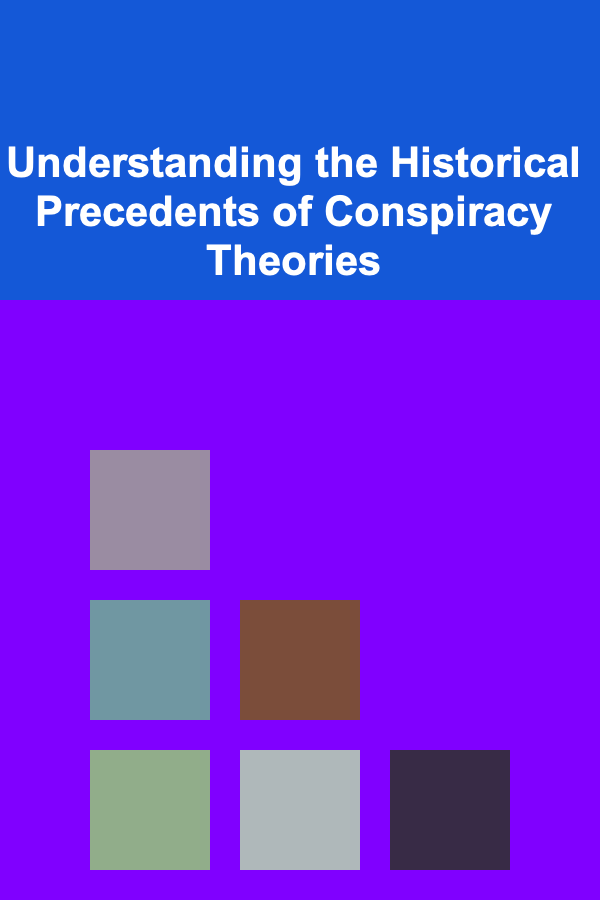
Understanding the Historical Precedents of Conspiracy Theories
ebook include PDF & Audio bundle (Micro Guide)
$12.99$11.99
Limited Time Offer! Order within the next:

Conspiracy theories, the beliefs that powerful, secretive groups are manipulating events for nefarious purposes, are pervasive throughout history and across cultures. They aren't a modern phenomenon; rather, they have deep historical roots that shape their form, content, and impact. To truly understand contemporary conspiracy theories, one must examine their historical precedents. This involves understanding the recurring narratives, the social and political contexts that foster them, the psychological needs they fulfill, and the ways in which they evolve over time. By tracing these historical threads, we can gain a deeper appreciation of why conspiracy theories are so persistent and what role they play in shaping our understanding of the world.
Recurring Narratives and Archetypes
One of the key aspects of understanding the historical precedents of conspiracy theories is recognizing the recurring narratives and archetypes that underpin them. While the specific actors and events may change, the underlying themes often remain remarkably consistent. These recurring narratives provide a framework for interpreting events and identifying perceived threats.
The Malevolent Elite
Perhaps the most common archetype in conspiracy theories is the malevolent elite. This narrative posits the existence of a small, powerful group that controls events from behind the scenes. This elite is typically portrayed as being secretive, ruthless, and driven by a lust for power. They may be identified as a specific group (e.g., Freemasons, Illuminati, Jews, bankers) or a more abstract entity (e.g., the New World Order, the Deep State). The belief in a malevolent elite dates back centuries, with historical examples including accusations against the Knights Templar in the 14th century and the anti-Semitic conspiracy theories that emerged in medieval Europe.
These early accusations often served as justifications for persecution and violence. For example, the accusations against the Knights Templar, fueled by King Philip IV of France's desire to seize their wealth, led to their dissolution and the execution of many members. Similarly, the anti-Semitic conspiracy theories, which alleged that Jews were plotting to control the world, contributed to centuries of discrimination and violence against Jewish communities.
Modern iterations of this narrative can be seen in theories about the Bilderberg Group, the Trilateral Commission, and the World Economic Forum, all of which are accused of secretly shaping global policy. The enduring appeal of this narrative lies in its ability to explain complex and seemingly inexplicable events by attributing them to a single, identifiable source of power. It also provides a sense of clarity and control in a chaotic world, offering a simple explanation for complex problems.
The Hidden Agenda
Closely related to the malevolent elite is the narrative of the hidden agenda. This involves the belief that events are not what they seem and that there is a secret motive behind them. This narrative often involves a cover-up, deception, and the manipulation of public opinion. The hidden agenda narrative can be applied to a wide range of events, from political assassinations to natural disasters.
Historical examples of the hidden agenda narrative include the widespread belief that the sinking of the Lusitania in 1915 was intentionally orchestrated by the British government to draw the United States into World War I. Another example is the persistent skepticism surrounding the assassination of President John F. Kennedy, with numerous theories alleging that the official account is a cover-up for a more complex conspiracy.
The appeal of the hidden agenda narrative lies in its ability to challenge official narratives and expose perceived lies. It fosters a sense of suspicion and distrust towards authority figures and institutions. This narrative is often fueled by a perceived lack of transparency and accountability, which can lead individuals to seek alternative explanations for events.
The Scapegoat
Another recurring narrative is the use of the scapegoat. This involves blaming a specific group or individual for societal problems or misfortunes. The scapegoat narrative often targets marginalized or vulnerable groups, providing a convenient explanation for complex issues and diverting attention from systemic problems.
Historical examples of scapegoating are numerous. During the Black Death in the 14th century, Jewish communities were often blamed for poisoning wells and spreading the disease, leading to widespread persecution and violence. Similarly, during the Salem Witch Trials in the 17th century, marginalized women were accused of witchcraft and held responsible for societal ills.
Modern examples of scapegoating can be seen in theories blaming immigrants for economic problems or Muslims for terrorism. The appeal of the scapegoat narrative lies in its simplicity and its ability to provide a sense of collective identity and solidarity. By identifying a common enemy, individuals can unite against a perceived threat and reinforce their own sense of belonging.
The Technological Threat
With the rise of technology, a new narrative has emerged: the technological threat. This narrative involves the belief that new technologies are being used for nefarious purposes, such as surveillance, mind control, or population control. This narrative often reflects anxieties about the increasing power and influence of technology in modern society.
Historical precedents for the technological threat narrative can be seen in anxieties about the printing press in the 15th century, which was initially viewed with suspicion and concern by some religious and political authorities who feared its potential to spread dissenting ideas. The Industrial Revolution also sparked fears about the dehumanizing effects of technology and the loss of traditional ways of life.
Modern examples of the technological threat narrative include theories about 5G technology causing health problems, microchips being implanted in vaccines for tracking purposes, and artificial intelligence being used to manipulate public opinion. The appeal of this narrative lies in its ability to tap into anxieties about the unknown and the potential consequences of technological advancements. It also reflects a fear of losing control and autonomy in an increasingly technologically driven world.
Social and Political Contexts
Conspiracy theories do not emerge in a vacuum. They are often rooted in specific social and political contexts that provide fertile ground for their growth. These contexts typically involve periods of uncertainty, instability, and distrust in authority.
Periods of Crisis and Uncertainty
Conspiracy theories tend to flourish during periods of crisis and uncertainty. This could include times of war, economic recession, political upheaval, or natural disasters. During these periods, individuals often feel a sense of vulnerability and anxiety, which can lead them to seek explanations for events that seem chaotic and unpredictable. Conspiracy theories provide a sense of order and control in these uncertain times by offering a simple and often emotionally satisfying explanation for complex events.
For example, the aftermath of the September 11th terrorist attacks saw a surge in conspiracy theories about the events, with some alleging that the attacks were an inside job or that the U.S. government had prior knowledge of the attacks and allowed them to happen. Similarly, the COVID-19 pandemic has fueled a wide range of conspiracy theories about the origins of the virus, the effectiveness of vaccines, and the motives of governments and health organizations. These theories provide a way for individuals to make sense of a confusing and frightening situation and to express their distrust of authority figures and institutions.
Distrust in Authority
Distrust in authority is another key factor that contributes to the spread of conspiracy theories. When individuals feel that they cannot trust their government, the media, or other institutions, they are more likely to seek alternative explanations for events. This distrust can be fueled by a perceived lack of transparency, corruption, or a sense that the interests of the powerful are being prioritized over the needs of ordinary people.
The Watergate scandal in the 1970s, for example, significantly eroded public trust in the U.S. government and contributed to a climate of suspicion and skepticism that continues to this day. The Iraq War, with its controversial justifications and lack of clear evidence of weapons of mass destruction, further fueled distrust in government and the media. The rise of social media has also contributed to this trend, as individuals are now able to bypass traditional sources of information and seek out alternative narratives that reinforce their existing beliefs.
Social and Economic Inequality
Social and economic inequality can also contribute to the spread of conspiracy theories. When individuals feel that they are being unfairly disadvantaged or that their opportunities are limited, they may be more likely to believe in theories that attribute their struggles to the actions of powerful and secretive groups. Conspiracy theories can provide a way for individuals to express their anger and frustration with the status quo and to challenge the legitimacy of existing power structures.
For example, populist movements, both on the left and the right, often draw on conspiracy theories to mobilize support and to challenge the established order. These theories typically target elites, such as wealthy corporations, political insiders, or cultural elites, and accuse them of manipulating the system for their own benefit. The appeal of these theories lies in their ability to tap into feelings of resentment and disenfranchisement and to offer a vision of a more just and equitable society.
Psychological Needs
Beyond the social and political contexts, conspiracy theories also fulfill certain psychological needs. These needs include the desire for understanding, control, and belonging.
The Need for Understanding
Humans have a fundamental need for understanding and meaning. When confronted with complex or confusing events, individuals seek explanations that can help them make sense of the world. Conspiracy theories provide a simplified and often emotionally satisfying explanation for these events, even if the explanation is not necessarily accurate. By attributing events to the actions of a specific group or individual, conspiracy theories can reduce uncertainty and provide a sense of cognitive closure.
This need for understanding is particularly strong during times of crisis and uncertainty, when individuals are struggling to cope with feelings of fear and anxiety. Conspiracy theories can offer a way to reduce these feelings by providing a clear and concise explanation for the events that are causing them.
The Need for Control
Humans also have a need for control over their lives and their environment. When individuals feel that they are losing control, they may be more likely to seek out conspiracy theories as a way to regain a sense of agency. By believing in a conspiracy theory, individuals can feel that they have a better understanding of the forces that are shaping their lives and that they are better equipped to protect themselves from potential threats.
For example, individuals who feel that they have little control over their economic situation may be more likely to believe in conspiracy theories about the global financial system or the manipulation of the stock market. These theories can provide a sense of understanding and control by attributing their economic struggles to the actions of powerful and secretive groups.
The Need for Belonging
Finally, humans have a need for belonging and connection with others. Conspiracy theories can provide a sense of community and solidarity for individuals who feel alienated or marginalized. By sharing their beliefs with others who share their worldview, individuals can reinforce their own sense of identity and belonging.
Online communities dedicated to specific conspiracy theories have become increasingly common in recent years. These communities provide a space for individuals to share information, discuss their beliefs, and support each other. The shared belief in a conspiracy theory can create a strong sense of connection and belonging, particularly for individuals who feel that they are not accepted or understood by mainstream society.
Evolution Over Time
Conspiracy theories are not static entities. They evolve over time, adapting to changing social, political, and technological landscapes. Understanding this evolution is crucial for understanding their contemporary forms.
Adaptation to New Technologies
Conspiracy theories have always adapted to new technologies. The printing press, the telegraph, radio, television, and the internet have all been used to disseminate conspiracy theories and to connect individuals who share similar beliefs. The internet, in particular, has had a profound impact on the spread of conspiracy theories, allowing them to reach a global audience and to connect individuals from diverse backgrounds.
Social media platforms have also played a significant role in the dissemination of conspiracy theories. The algorithms that govern these platforms can create echo chambers, where individuals are primarily exposed to information that confirms their existing beliefs. This can reinforce conspiracy theories and make it more difficult for individuals to encounter alternative perspectives.
Incorporation of New Events
Conspiracy theories often incorporate new events into their existing narratives. When a major event occurs, such as a political assassination, a natural disaster, or a terrorist attack, conspiracy theories often emerge that attempt to explain the event in terms of a larger, pre-existing conspiracy. This can involve reinterpreting existing evidence, creating new evidence, or linking the event to other unrelated events.
For example, the COVID-19 pandemic has been incorporated into a wide range of existing conspiracy theories, including theories about the New World Order, population control, and the dangers of vaccines. This incorporation of new events allows conspiracy theories to remain relevant and to appeal to a wider audience.
Blurring of Fact and Fiction
In recent years, there has been a growing trend towards the blurring of fact and fiction in conspiracy theories. This involves the use of disinformation, misinformation, and propaganda to deliberately mislead the public and to promote false narratives. This blurring of fact and fiction can make it more difficult for individuals to distinguish between credible information and conspiracy theories.
The rise of "fake news" and the proliferation of disinformation campaigns on social media have contributed to this trend. These campaigns often target specific groups or individuals with the goal of undermining their trust in institutions and spreading confusion and division. The consequences of this blurring of fact and fiction can be significant, eroding public trust, undermining democratic institutions, and contributing to political polarization.
Conclusion
Understanding the historical precedents of conspiracy theories is crucial for understanding their persistence and their impact on society. By examining the recurring narratives, the social and political contexts, the psychological needs, and the evolution over time, we can gain a deeper appreciation of why conspiracy theories are so appealing to some individuals and what role they play in shaping our understanding of the world.
It is important to remember that conspiracy theories are not simply harmless beliefs. They can have real-world consequences, leading to violence, discrimination, and the erosion of public trust. By understanding the historical roots of conspiracy theories, we can be better equipped to critically evaluate information, to resist the spread of misinformation, and to promote a more informed and rational public discourse.
Furthermore, recognizing the underlying psychological needs that conspiracy theories attempt to fulfill can help us develop more effective strategies for addressing the root causes of belief in conspiracy theories. This might involve promoting critical thinking skills, fostering trust in institutions, and addressing social and economic inequalities. Ultimately, understanding the historical precedents of conspiracy theories is essential for building a more resilient and informed society.
Reading More From Our Other Websites
- [Personal Investment 101] How to Invest in Gold ETFs: Your Complete Guide to Diversifying with Precious Metals
- [Metal Stamping Tip 101] Innovations in Metal Stamping: Rapid Prototyping Techniques That Cut Lead Times
- [Personal Finance Management 101] How to Cut Back on Dining Out and Still Enjoy Meals
- [Personal Care Tips 101] How to Make the Most of Your Teeth Whitening Strips for Fast Results
- [Home Storage Solution 101] How to Maximize Bathroom Storage with Clever Organization Tips
- [Personal Care Tips 101] How to Choose a Moisturizer for Winter Skin Care
- [Biking 101] Why Cycling Events Are the Ultimate Test of Endurance and Skill
- [Home Pet Care 101] How to Build a Safe Outdoor Space for Your Pet at Home
- [Home Maintenance 101] How to Properly Install Insulation in Your Home for Maximum Energy Efficiency
- [Personal Care Tips 101] How to Apply Blush for a Natural Look

How to Maximize Closet Space Using Adjustable Shelving
Read More
How to Save for Your Child's Education
Read More
How to Transform Your Pantry with Budget-Friendly Thrifty Pantry Organization Ideas
Read More
How to Use Customer Feedback from Returns and Refunds to Improve Your Dropshipping Store
Read More
The Ultimate Guide to Saving for Retirement Strategies and Building Wealth
Read More
How to Build a Christmas Gift List Checklist for Teens
Read MoreOther Products

How to Maximize Closet Space Using Adjustable Shelving
Read More
How to Save for Your Child's Education
Read More
How to Transform Your Pantry with Budget-Friendly Thrifty Pantry Organization Ideas
Read More
How to Use Customer Feedback from Returns and Refunds to Improve Your Dropshipping Store
Read More
The Ultimate Guide to Saving for Retirement Strategies and Building Wealth
Read More